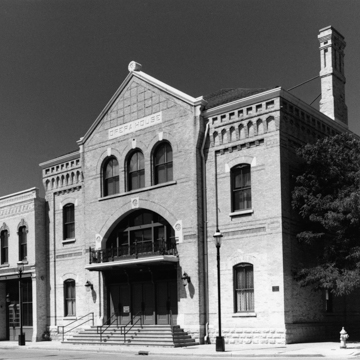The Grand Opera House hosted a veritable Who’s Who of famous figures in theater, music, dance, and literature, including Enrico Caruso, Anna Pavlova, Sarah Bernhardt, George M. Cohan, John Philip Sousa, Jenny Lind, and Mark Twain. The opera house’s location between Chicago and Minneapolis explains why many theater and vaudeville companies stopped here, often to try out their shows before setting out to tour the East Coast, where critics were presumably more demanding. “But they loved me in Oshkosh!” became a standard vaudevillian protest when a joke fell flat. The Romanesque Revival building has cream brick walls accented with bands of black brick. Above the broad entrance arch is a trio of round-arched windows, topped by a checkerboard-patterned gable. A dramatic two-tiered corbel table caps the flanking bays. Waters designed the building during the heyday of live theater, when auditoriums tried to evoke a sense of spectacle and palatial grandeur. The interior of the Grand Opera House has excellent acoustics and is visually dazzling. Luxurious detailing includes a grand balcony with a spindle balustrade, ornate plaster details, and elaborate stencil work. The City of Oshkosh renovated the opera house in 2009.
You are here
Grand Opera House
If SAH Archipedia has been useful to you, please consider supporting it.
SAH Archipedia tells the story of the United States through its buildings, landscapes, and cities. This freely available resource empowers the public with authoritative knowledge that deepens their understanding and appreciation of the built environment. But the Society of Architectural Historians, which created SAH Archipedia with University of Virginia Press, needs your support to maintain the high-caliber research, writing, photography, cartography, editing, design, and programming that make SAH Archipedia a trusted online resource available to all who value the history of place, heritage tourism, and learning.





















